- Afrikaans
- Albanian
- Amharic
- Arabic
- Armenian
- Azerbaijani
- Basque
- Belarusian
- Bengali
- Bosnian
- Bulgarian
- Catalan
- Cebuano
- Corsican
- Croatian
- Czech
- Danish
- Dutch
- English
- Esperanto
- Estonian
- Finnish
- French
- Frisian
- Galician
- Georgian
- German
- Greek
- Gujarati
- Haitian Creole
- hausa
- hawaiian
- Hebrew
- Hindi
- Miao
- Hungarian
- Icelandic
- igbo
- Indonesian
- irish
- Italian
- Japanese
- Javanese
- Kannada
- kazakh
- Khmer
- Rwandese
- Korean
- Kurdish
- Kyrgyz
- Lao
- Latin
- Latvian
- Lithuanian
- Luxembourgish
- Macedonian
- Malgashi
- Malay
- Malayalam
- Maltese
- Maori
- Marathi
- Mongolian
- Myanmar
- Nepali
- Norwegian
- Norwegian
- Occitan
- Pashto
- Persian
- Polish
- Portuguese
- Punjabi
- Romanian
- Russian
- Samoan
- Scottish Gaelic
- Serbian
- Sesotho
- Shona
- Sindhi
- Sinhala
- Slovak
- Slovenian
- Somali
- Spanish
- Sundanese
- Swahili
- Swedish
- Tagalog
- Tajik
- Tamil
- Tatar
- Telugu
- Thai
- Turkish
- Turkmen
- Ukrainian
- Urdu
- Uighur
- Uzbek
- Vietnamese
- Welsh
- Bantu
- Yiddish
- Yoruba
- Zulu
Understanding the Function and Importance of a Pup Joint in Pipe Systems
Understanding What a Pup Joint Is
In the realm of pipeline construction and maintenance, terminology often plays a crucial role in ensuring clarity and efficiency. One such term that frequently arises is pup joint. Understanding what a pup joint is and its practical applications can be of significant benefit to professionals in the oil and gas industry as well as those working with piping systems in general.
Definition of Pup Joint
A pup joint is a short length of pipe that is typically used in oil and gas industries. The length of a pup joint can vary, but it generally ranges from 18 inches to 5 feet. They are available in various pipe sizes and materials, depending on the specific requirements of the pipeline system in which they will be used. Pup joints are essentially small sections that help adjust the overall length of a pipeline or facilitate the proper alignment and connection of larger pipe segments.
Purpose of Pup Joints
The primary purpose of a pup joint is to make minor adjustments in length during the installation of pipelines. For instance, when constructing or repairing a pipeline, engineers may find that pipe segments do not fit together perfectly due to various factors such as ground settling, thermal expansion, or design specifications. In such cases, pup joints are employed to ensure a tight, leak-proof fit without requiring the installation of custom-cut pipe segments.
Moreover, they are used to connect different pipe sizes or materials, helping to maintain the integrity and flow characteristics of the pipeline system. Because pup joints can accommodate connections between differing pipe types—like steel, PVC, or other materials—this versatility can be crucial when dealing with diverse piping systems.
Applications of Pup Joints
what is a pup joint

Pup joints find extensive use in numerous applications within construction, oil, and gas industries. Some notable uses include
1. Pipeline Construction During the installation of crude oil or natural gas pipelines, pup joints allow for precise length adjustments that are critical for maintaining flow rates and pressure.
2. Rigging In drilling operations, pup joints can be used in the drill string to adjust the length between the surface equipment and the drill bit, thereby providing necessary flexibility for drilling operations.
3. Fluid Transfer In processing plants, pup joints can connect sections of piping that transfer fluids, ensuring that chemicals and other materials flow efficiently.
4. Maintenance and Repair When replacing sections of a pipeline, pup joints offer quick and effective solutions to restore the system, minimizing downtime and improving operational efficiency.
Conclusion
In summary, a pup joint is a beneficial component in the world of piping and pipeline systems, particularly within the oil and gas industry. By enabling precise adjustments in pipeline lengths, facilitating connections between different pipe types, and supporting efficient maintenance and repair operations, pup joints contribute significantly to the integrity and functionality of various piping systems. Understanding the characteristics and applications of pup joints empowers professionals to enhance their operations and ensure the reliability of the pipelines they manage. As industries continue to evolve, the importance of components like pup joints will remain a foundational aspect of effective engineering and construction practices.
-
Tubing Pup Joints: Essential Components for Oil and Gas OperationsNewsJul.10,2025
-
Pup Joints: Essential Components for Reliable Drilling OperationsNewsJul.10,2025
-
Pipe Couplings: Connecting Your World EfficientlyNewsJul.10,2025
-
Mastering Oilfield Operations with Quality Tubing and CasingNewsJul.10,2025
-
High-Quality Casing Couplings for Every NeedNewsJul.10,2025
-
Boost Your Drilling Efficiency with Premium Crossover Tools & Seating NipplesNewsJul.10,2025







